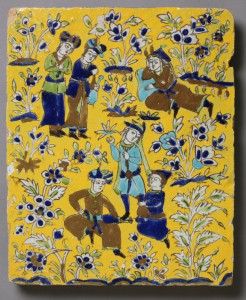(Spanish: “dry cord”). A technique for applying colored glazes to ceramic surfaces, introduced in Islamic Spain in the 10th century. In the cuerda seca process, thin bands of waxy resist maintain separation between colored glazes during firing, leaving behind unglazed “dry cords”. Large quantities of cuerda seca tiles were produced in Turkey, Central Asia and Iran during the Timurid (1370–1507) and Safavid (1501–1736) periods.
 Tile with scene of figures in a garden. Fritware with polychrome decoration under clear glaze in cuerda seca technique. 17th century or later. Portland Art Museum, Portland, Oregon.
Tile with scene of figures in a garden. Fritware with polychrome decoration under clear glaze in cuerda seca technique. 17th century or later. Portland Art Museum, Portland, Oregon.